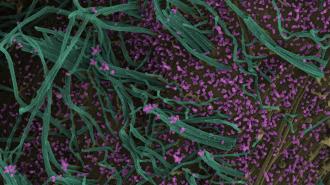“This is just the start of what I think will be a long journey, of hopefully very interesting discoveries,” Pablo Murcia, a virology professor at the University of Glasgow, told The Guardian.
“Interesting” is definitely one way to put it. I would call it equal parts fascinating and frightening.
Murcia was talking about something researchers say has never before been observed: two different viruses, stitching themselves together to become one. A frankenvirus, if you will.
And just in time for Halloween.
Researchers have discovered viruses forming new, hybrid forms, something never seen before.
Double, double toil and trouble: The hybrid virus, discovered by a team led by first author Joanne Haney at the MRC-University of Glasgow Centre for Virus Research, was formed from two common threats — influenza A and RSV.
Although thus far only observed in human lung cells in the lab, the hybrid virus’s ability to infect lung cells may provide clues about viral coinfection, when an unlucky patient plays host to two pathogens at once.
Coinfections occur in roughly 10-30% of respiratory infections, and are more common in children, the researchers wrote in their study, published in Nature Microbiology.
Despite their relative frequency, the impact of coinfections — like many things in immunology and virology — remains as murky as a scrying mirror. Some studies suggest they mean diddly, while others report increased risk of viral pneumonia.
“Respiratory viruses exist as part of a community of many viruses that all target the same region of the body, like an ecological niche,” Haney said in a release. “We need to understand how these infections occur within the context of one another to gain a fuller picture of the biology of each individual virus.”
And there’s no shortage of those viruses haunting humanity.
The hybrid virus was formed by influenza A and RSV, common respiratory infection threats.
Frankenvirus: During flu season, the WHO estimates that flu infects up to 20% of the world’s population, with most cases caused by influenza A viruses. Strains of influenza A are also widespread in animals, making it a perpetual threat to spawn flu pandemics.
RSV, short for “respiratory syncytial virus,” is the leading cause of acute lower respiratory tract infections in children under 5, infecting millions of kids every year. RSV is no fun for adults, either, but is much more serious for the elderly, killing thousands of adults over 65 each year, per the CDC.
To study how these two viruses may interact with one another, the team took human lung cells and infected them with both viruses. Instead of enacting an Alien vs. Predator, they formed an unholy union. What the team discovered, via sophisticated imaging, were two new hybrid virus particles that incorporated pieces of both viruses, including genetic information.
The Guardian describes it as resembling a palm tree — but if you ask me, it more resembles a spindly-spider-monster, with RSV forming the body and influenza providing the legs.
“This kind of hybrid virus has never been described before,” Murcia told The Guardian. “We are talking about viruses from two completely different families combining together with the genomes and the external proteins of both viruses. It is a new type of virus pathogen.”
It’s alive! (kind of): These weren’t just defanged oddities, either: inside both individual and layered lung cells, the hybrids were capable of infection and reproduction, while dodging the immune system and antibodies against its parent viruses.
It’s important to note that this all happened in cells in a lab: it’s currently unknown whether these types of hybrid viruses are ever really created during coinfection of actual patients. Previous research has in fact suggested the opposite — that some respiratory infections trigger immune responses that fight off other ones.
The hybrid viruses were capable of infecting human lung cells in the lab. It is currently unknown if they form in people who have coinfections.
While this is pretty freaky — my dad, who has spent a career fighting viruses, suggested they “kill it immediately” when I called to tell him about it, and I think he was only half kidding — the hybrid virus could be an important discovery.
“Coinfection studies can help us in preparing for future pandemics by understanding how the introduction of one virus can influence and interact with other circulating viruses,” Haney said in the release.
The team says the next step is finding out if these frankenviruses form in patients with coinfections, and identifying which viruses may be capable of pigeon-ratting themselves. Their assumption is that only a few respiratory viruses will ever do so — but then again, we didn’t know until now that they could do it at all.
In the meantime, maybe the incinerator isn’t the worst idea.
We’d love to hear from you! If you have a comment about this article or if you have a tip for a future Freethink story, please email us at [email protected].






